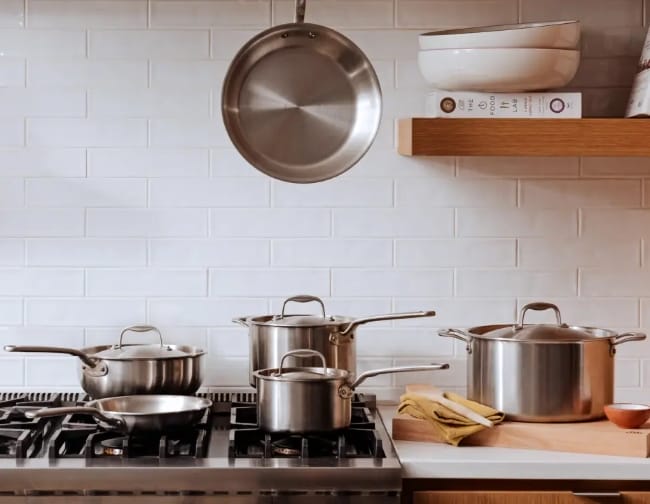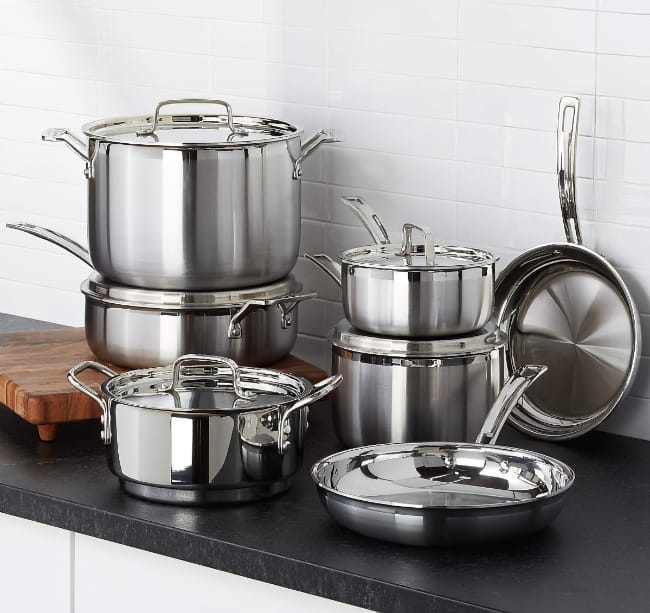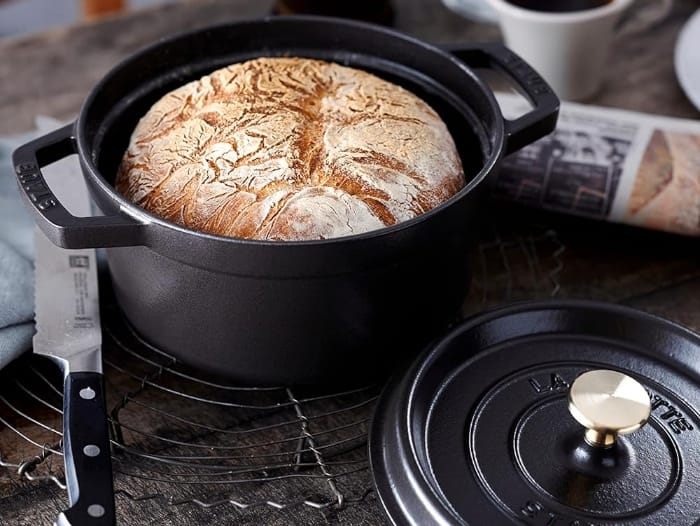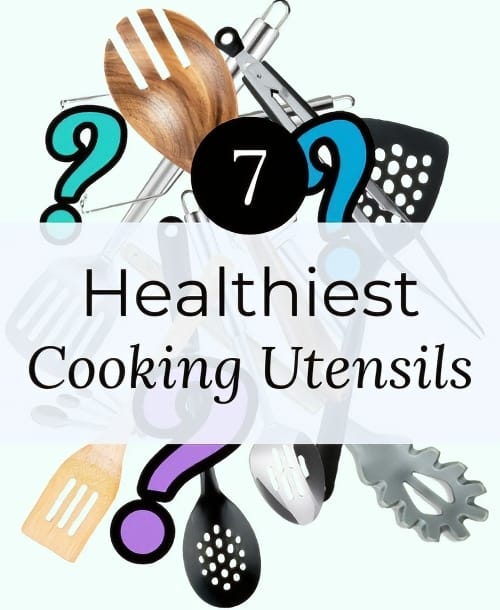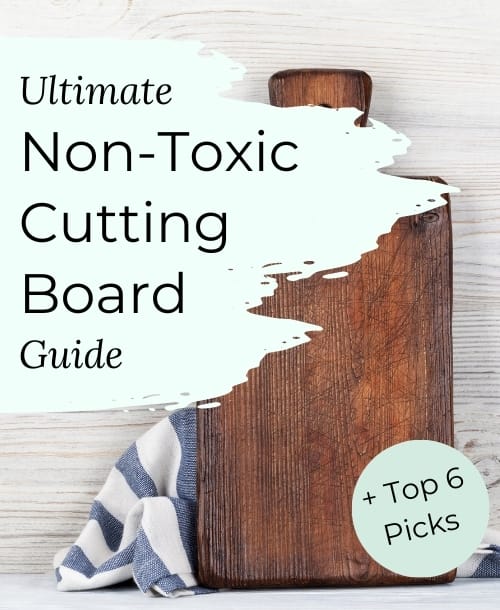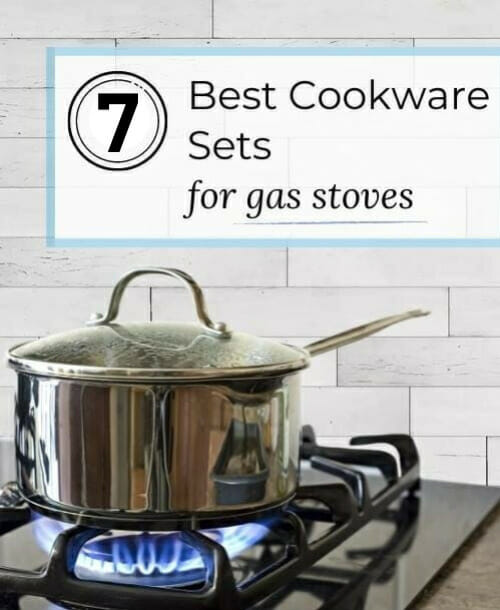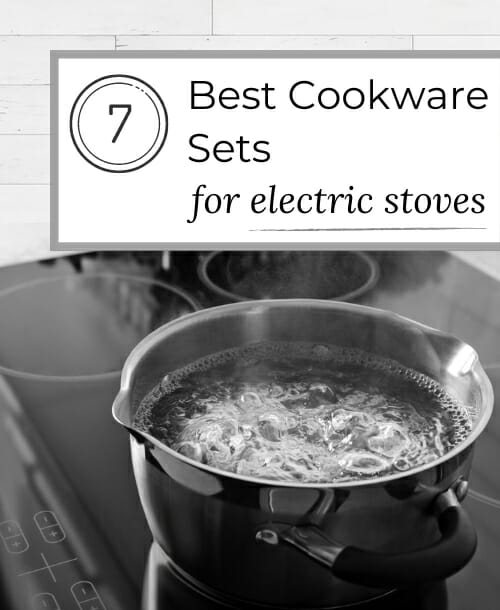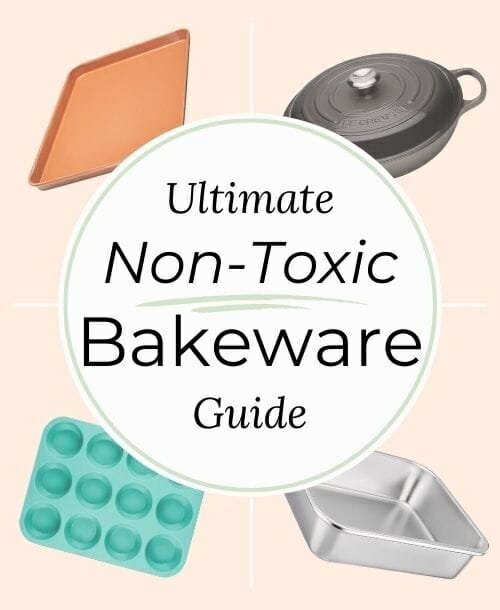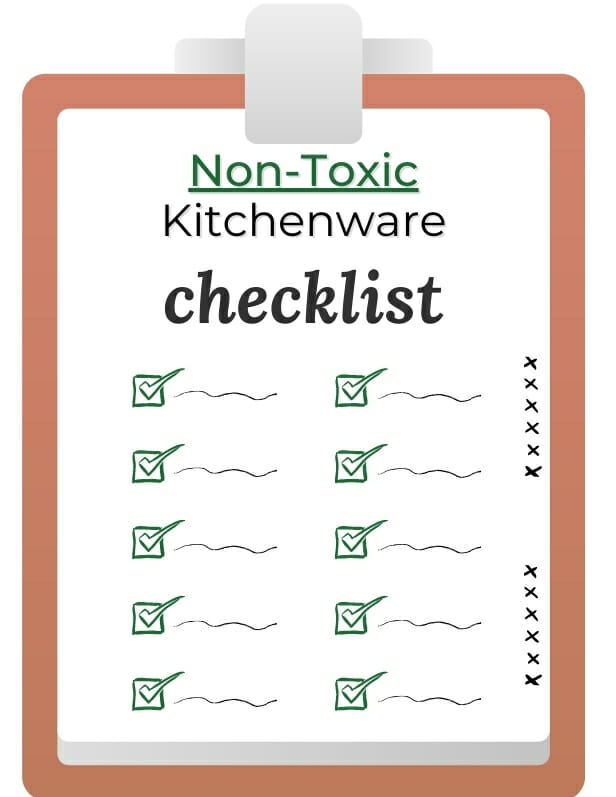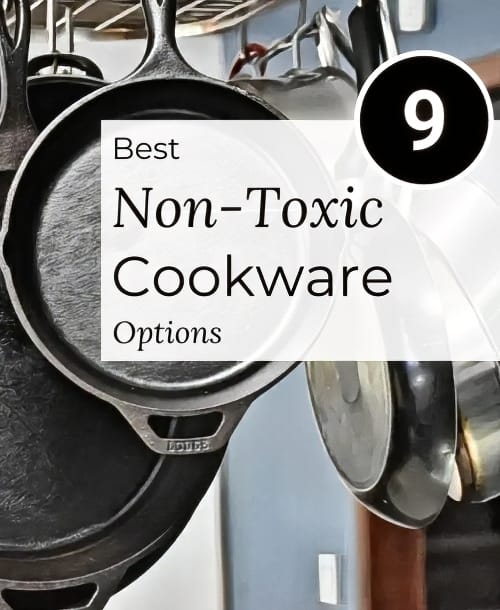
Eating healthy food is a priority for many, yet our cookware often escapes our scrutiny. Non-stick pans make cooking easier but come with a hidden health risk. Many use PFAS chemicals, which can be harmful over time, even in newer, PFOA-free versions. More on that next.
With all the confusion about safe levels of PFAS, it’s wise to choose non-toxic cookware free from these chemicals. Cast iron and stainless steel are great options, with ceramic non-stick being the closest Teflon alternative (when bought from a reputable company).
But PFAS isn’t the only thing to watch out for, though it’s a big one.
In this article, we’ll explain which cookware to avoid and what makes a pan truly non-toxic. After much testing and expert consultation, we’ve found the nine healthiest cookware brands for you – each thoroughly reviewed below.
Let’s dive in!
Medically-reviewed by Dr. Ahmad Alsayes, MBBS
Safest Cookware Picks: At a Glance
Click to skip ahead to each brand’s in-depth review:
- Best Overall: Demeyere 5-Plus
- Best Stainless Steel Set: Made-In 5-ply
- Best Budget Set: Cuisinart Multiclad Pro
- Best Non-Stick Set: Caraway
- Best-Performing Non-Stick: GreenPan GP5
- Most Versatile Pan: Our Place Always Pan 2.0
- Overall Safest Cookware: Xtrema Pure Ceramic
- Best Overall Cast Iron & Carbon Steel: Lodge
- Best Enameled Cast Iron: Staub
Cookware Types to Avoid: The Bottom Line on Non-Stick
Key Takeaways:
- Be Wary of PFAS in Non-Stick Cookware: Despite today’s non-stick pans being labeled “PFOA-free,” they may still contain other harmful PFAS chemicals, which can accumulate in the body and environment, posing serious health risks.
- Choose Safer Alternatives: It’s best to avoid PFAS-containing cookware for health and safety. Opt for non-stick alternatives like ceramic-coated pans that don’t carry these risks.
The Details: Before 2013, the PFAS chemicals PFOA and PFOS were used to make Teflon coatings. However, overheating these pans (above 482℉) was causing toxic fumes to off-gas; this experiment shows in as little as 1 ¾ minutes.
So, due to health concerns (including the increased risk of prostate, testicular, kidney, and ovarian cancers with increased PFOA exposure), Teflon pans sold today are free from PFOA/ OS.
Yet, today’s “PFOA-free” cookware is misleading; it can contain other PFAS like Genx chemicals (there are thousands of PFAS).
Research into the safety of PFOA-free coatings is limited. But, studies show that PFAS (named “Forever chemicals”) do not break down. They accumulate in our bodies and the environment over time. This raises concerns, as excessive PFAS levels share links to kidney and testicular cancer and developmental delays in infants. And we still don’t know how much PFAS is safe to ingest.
So, it’s safest to avoid PFAS altogether. Plenty of PFAS-free, non-stick alternatives exist, such as ceramic-coated pans. And you can use most cookware for sticky foods with a few tips. More on that below.
Other cookware concerns (use caution):
- Bare aluminum: Great at conducting heat but can leach metal into your food if it’s not anodized. Now, unless you have kidney failure, aluminum absorption from food is generally safe. However, some sources claim links to Alzheimer’s and dementia.
- Leachable lead & cadmium in glazes: Brightly colored ceramic and enameled cookware may leach harmful lead if not made properly. So, always opt for credible companies with transparent safety (like Xtrema) and avoid antique ceramics.
- Titanium dioxide nanoparticles: Some low-quality quasi-ceramic pans use this for a non-stick effect. These particles can leach into your food, especially if the pan becomes scratched. And we’re still unsure of titanium dioxide’s human health impacts, though animal studies show concern. Choose only high-quality, well-known brands like Caraway or Greenpan.
What makes Cookware Non-Toxic? Safety Criteria & Best Materials
Key Takeaways:
- Prioritize PFAS-Free Options: The primary criterion for “toxin-free” cookware is the absence of PFAS coatings. Safe non-stick alternatives, like ceramic-coated cookware, are available; just ensure the product is labeled as “PFAS-free” and/ or “ceramic-coated.” Besides avoiding PFAS, steer clear of chipped or antique ceramics and use caution with bare aluminum.
Best Types of Non-Toxic Cookware:
- Stainless steel: Durable, versatile, and non-reactive, but not naturally non-stick. Requires proper preheating and oiling to prevent sticking.
- Cast iron: Excellent heat retention and searing ability, naturally non-stick with proper seasoning. Heavy and requires seasoning maintenance.
- Carbon steel: Like cast iron, but lighter and heats up faster. Requires seasoning maintenance.
- Ceramic-coated: PFAS-free alternative to traditional non-stick, but the coating can eventually break down. Requires careful use and cleaning.
- Solid ceramic: Made from natural clay, oven-safe, and can handle high heat. It can be fragile and expensive.
The Details: Ceramic-coated pans are not quite as non-stick as Teflon; they demand a little oil to work best. That said, it’s an egg-friendly option free from toxic fume risk.
The key is ensuring you see the words “PFAS-free” and “ceramic-coated.” Some proprietary Teflon-free coatings still use PFAS, like the Ozeri Stone Earth’s “natural, stone-derived coating.”
Aside from material safety, cookware should remain safe and undamaged, even at high temperatures. Ceramic-coated pans are safe, yes. However, high-heat cooking techniques and metal utensils degrade their non-stick coating.
That’s why I recommend stainless steel, cast iron, and carbon steel over ceramic-coated pans, despite their learning curve.
They’re non-toxic, can last a lifetime (no coatings), and work with all cooking methods and temperatures. And with proper preheating and oiling, they make great non-stick alternatives. I’ve found that preheating the empty pan on medium for a few minutes before adding oil – then adding food on top – prevents most sticking.
Solid ceramic and glass are also safe cookware materials but note their fragility. Avoid using soda-lime glass bakeware on the stove due to its risk of breakage. Aim instead for thermal shock-resistant borosilicate, pyroceram (Corningware), or calexium (Visions) glass.
Next, let’s explore our top non-toxic cookware picks that passed the finish line after our evaluation process – covered in detail later.

9 Best Non-Toxic Cookware Options | Reviewed
1. Demeyere 5-Plus
Best Overall
- Material/ Ply: 18/10 stainless steel, aluminum core; 5-ply. Zero PFAS
- Dishwasher-safe? Yes, but handwashing preferred
- Stove compatibility & heat tolerance: All cooktops, including induction. Oven & broiler safe to 500℉
- Price (at time of publishing): $999.95 for 10pc set [Check latest]
- Warranty: Lifetime
- Where it’s made: Belgium
- Also available: 14pc set
Made with stainless steel and a triple aluminum core, this set is durable, versatile, and free of PFAS. It offers balanced heating speed and retention with an easy-cleaning Silvinox finish. Note the fry pans lack lids, limiting some cooking tasks.
Demeyere’s Belgium-made 5-Plus combines stainless steel’s versatility with the heating speed of hard-anodized cookware.
Its thick, 5-ply design features a triple aluminum core and stainless exterior. With a non-reactive, coating-free surface, this pan handles acidic ingredients, metal utensils, and high heat. And the 18/0 “stay-flat” base prevents permanent warping, ensuring even oil spread.
What sets Demeyere apart is its Silvinox surface treatment. This finishing removes impurities for a smoother, less sticky, easier-to-clean steel.
Demeyere outperformed other stainless sets in cooking trials, particularly in cooking eggs. With solid heat retention and Silvinox, less food debris remained on Demeyere than on All-Clad. Note: Despite being dishwasher-safe, I suggest handwashing to maintain the steel’s clarity.
I found Demeyere to boil water faster than steel core 5-ply, thanks to its fast-heating triple aluminum core. Though slightly less heat retention, it proved sufficient to give my N.Y. strip the right texture. And Demeyere’s slower, more gradual heating (compared to triple-ply pans) is more forgiving if you go too hot. This reduces the risk of scorching.
Demeyere’s 5-ply cookware excels for daily use by balancing versatility and ease. Lighter than steel core 5-ply, the pans are comfortable to use. Their heat-diffusing handles stayed cool through searing tests. Demeyere was also easier to clean than others, with Silvinox and rivetless handles for a smooth interior. While this 10-piece set covers the basics, the fry pans lack lids.

2. Made-In 5-Ply
Best Stainless Steel Set
- Material/ Ply: 18/10 stainless steel, aluminum core; 5-ply. Zero PFAS
- Dishwasher-safe? Yes, but handwashing preferred
- Stove compatibility & heat tolerance: All cooktops, including induction. Oven & broiler safe to 800℉
- Price (at time of publishing): $778 for 10pc set [Check latest]
- Warranty: Lifetime
- Where it’s made: Italy
Similar to Demeyere in heating ability but at a lower price. It’s made in Italy and perfect for high-heat cooking. Note the fry pans lack lids, and the handle rivets can collect food debris.
- 8″ frying pan
- 10″ frying pan
- 8-qt covered stock pot
- 4-qt covered saucepan (not sold individually)
- 2-qt covered saucepan
- 3-qt covered saucier pan
Made-In’s 5-ply Italian-made stainless steel set includes all the brand’s top sellers. It’s (almost) as good as Demeyere but more affordable. Made-In also uses a three-layer aluminum core and 18/10 stainless steel outer layer – offering a balance of heat retention and responsiveness.
In our tests, Made-In matched Demeyere in heating speed and meat searing. The main difference? Made-In pans were a bit harder to clean, but soaking them removed any leftover bits. I found it was still easier to wash by hand than Cuisinart’s Multiclad Pro.
With stainless steel lids and an 800℉ heat tolerance (the highest I’ve seen), Made-In shines for high-heat stove-to-oven use. Just note the fry pans lack lids.
In handling, Made-In’s relatively lighter weight and stay-cool handles were comfortable during extended use. The handles do get warm in the oven but cool down fast, thanks to their hollow design. But unlike Demeyere, these handles are riveted, so expect some food debris to collect.
Overall, Made-In stands out as a top performer at its price. While similar options are available at this price, I chose Made-In for its proven track record of happy users and safety transparency. Their website’s recycling program also adds a nice touch on sustainability.

3. Cuisinart Multiclad Pro
Best Budget Set
- Material/ Ply: 18/10 stainless steel, aluminum core; 3-ply. Zero PFAS
- Dishwasher-safe? Yes, but hand washing preferred
- Stove compatibility & heat tolerance: All cooktops, including induction. Oven & broiler safe to 550℉
- Price (at time of publishing): $277 for 12pc set [Check latest]
- Warranty: Lifetime
- Where it’s made: China
- Also available: 13pc set; 15pc set
Heats up faster than 5-ply sets, offering quick temperature changes and excellent value, especially under $300. It mirrors All-Clad’s D3 at a fraction of the price. But, it’s easier to burn food than slower-heating 5-ply; riveted handles may collect food debris.
The Multiclad Pro’s design features three layers: an 18/10 stainless steel outside and an aluminum core. This combination heats faster than thicker 5-ply sets. It’s great for changing temperatures fast, like moving from browning meat to simmering a sauce.
It boiled water faster than 5-ply Demeyere, Made-In, and All-Clad in tests. But this means it’s easier to burn food than 5-ply if temperatures are too high. Also, three-layer pans cool faster, meaning less heat retention (searing ability) than 5-ply.
Still, when I compare it to All-Clad’s D3, the Multiclad Pro set stands out as the best option under $300. They’re pretty similar in how quickly they respond to heat changes.
In cooking eggs, the Multiclad Pro did have more sticking than All-Clad’s D3. That said, a brief soak lifted the residue quickly. Another difference is the Mutliclad’s steeper sides, which help prevent spillover.
Aside from that, the two are pretty much even in performance, using the same materials and design. But Cuisinart’s set costs less than half of the D3, making it a smart, high-performance budget pick.
This set has all the basics: skillets, saucepans, a sauté pan, a stockpot, and a universal steamer. The stainless steel lids are broiler-safe up to 550℉, a step up from Cuisinart’s TPS-10 (glass lids). I found the handles’ vented design to stay cool during extended testing. But, they are riveted, so expect food debris to collect on the inside.
Overall, the Multiclad Pro gives you the most bang for your buck out of all the options we’ve looked at.
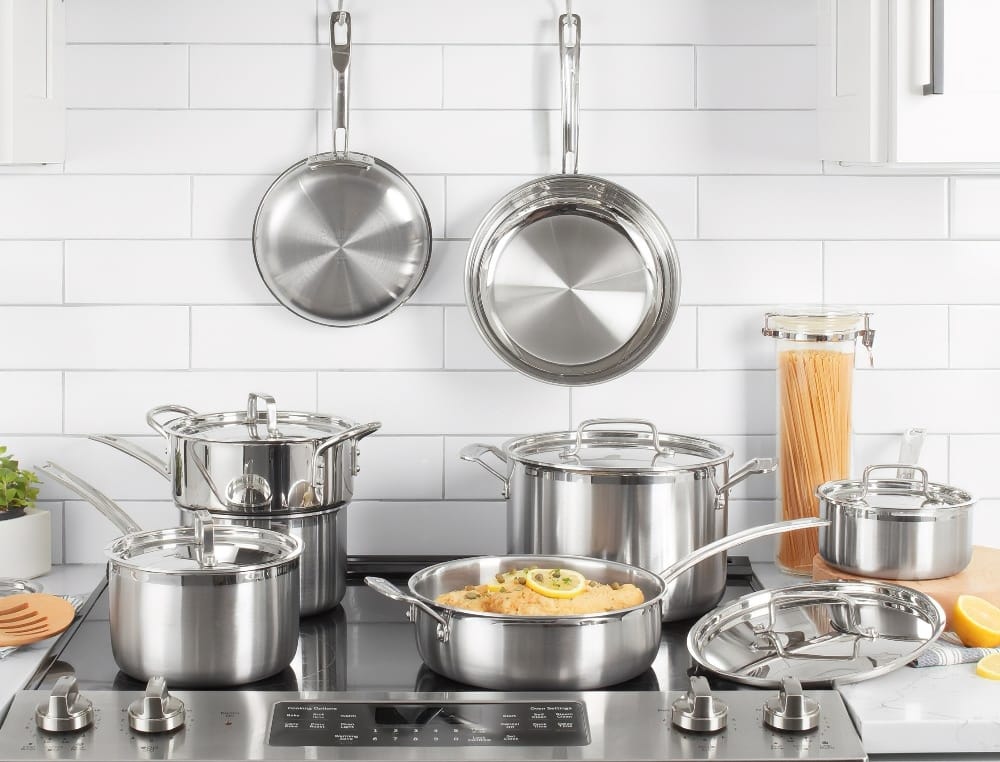
4. Caraway
Best Non-Stick Set
- Material/ Ply: Aluminum base with non-stick ceramic coating. Zero PFAS
- Dishwasher-safe? No
- Stove compatibility & heat tolerance: All cooktops, including induction. Oven-safe to 550℉.
- Price (at time of publishing): $355.50 for 12pc set [Check latest]
- Warranty: 1-year
- Where it’s made: BSCI/ SMETA-approved factories in China
- Also available: 2pc set; 3pc set; Steamer pot duo
PFAS-free ceramic coating ensures safe use and easy cleaning without harmful fumes, even at high temperatures. Lots of stylish colors are available. But, it’s not as non-stick as Teflon, demanding careful heating and oil use to work best.
- 10.5″ frying pan
- 3-qt covered saucepan
- 6.5-qt covered Dutch oven
- 4.5-qt covered sauté pan
- Modular magnetic pan racks x4 (not sold individually)
- Canvas lid holder with hanging hooks (not sold individually)
Caraway’s PFAS-free ceramic coating is a true Teflon alternative, offering easy cooking and cleaning. While not as non-stick as Teflon, the peace of mind is worth the sacrifice. Even if the pan gets too hot, Caraway doesn’t emit PFAS fumes.
In egg tests, a little oil over medium heat prevented sticking entirely. Cleanup took seconds. But high heat, not using oil, and not letting the pan preheat caused some sticking. Yet, it’s nothing a sponge can’t handle. Sticking with low-medium heat, hand washing, and non-metal utensils is best here.
This thickness helps distribute heat evenly and retains it better than thinner pans, reducing the chance of food sticking. While it might not be the best for searing steaks, it excels with foods that tend to stick.
Each piece but the frying pan includes a ceramic-coated aluminum lid. The steel handles, with heat-diffusing designs, stayed comfortable throughout most of my testing. They did get warm during high heat tests, but it’s best to stay below medium heat with ceramic anyway.
Lastly, Caraway stands out for its variety, offering cookware in eight stylish colors. They also sell pots and pans individually, with bakeware and food storage available as well. Beyond safe materials, Caraway’s ethical manufacturing and plastic-free packaging make them a conscious choice.

5. Greenpan GP5 Black
Best-Performing Non-Stick
- Material/ Ply: Hard-anodized aluminum base with non-stick ceramic coating
- Dishwasher-safe? Yes, but handwashing preferred
- Stove compatibility & heat tolerance: All cooktops, including induction. Oven-safe to 600℉.
- Price (at time of publishing): $859.99 for the 11pc set [Check latest]
- Warranty: Limited lifetime
- Where it’s made: Italy and China
- Also available: 2pc set; GP5 Colors collection
Stands out in performance and longevity, with superior heat retention and a durable, diamond-reinforced ceramic coating. That said, it’s costly and lacks the versatility of stainless steel.
- 9.5″ frypan (not sold individually – 8″ single available)
- 11″ frypan (not sold individually – 12″ single available)
- 3-qt covered saucepan (not sold individually – 2-qt single available)
- 3-qt covered sauté pan (not sold individually)
- 5-qt covered stockpot (not sold individually – 8-qt single available)
- Silicone utensils x3
- Pan protectors x3
GreenPan’s GP5 is their top ceramic-coated pan, packed with 16 years of innovation. I immediately noticed the heft of its 5mm-thick hard-anodized base, the thickest I’ve tested.
Combined with its Balance Pro base—an induction-ready, anti-warp plate—the GP5 held heat better than other brands like Caraway and Blue Diamond. This means your food cooks more evenly, with less chance of sticking or burning. But you do sacrifice some heating speed for retention, boiling water a little slower than Caraway.
In searing tests, the GP5 browned food better than Caraway but didn’t quite match up to cladded steel. Its INFINITE8 ceramic coating matched Caraway in food release during egg tests. But the GP5’s diamond-reinforced coating claims to last longer, helping to justify its higher cost.
Although labeled dishwasher and metal utensil-safe, I’d suggest against both to extend the coating’s lifespan. Just cooking on medium heat with some oil makes cleaning by hand easy. And the reverse-riveted steel handles ensure a snag-free cleanup.
Unlike Caraway, the GP5 uses rugged stainless steel lids with a low dome design, easily sliding into tight ovens. Its heat-vented handles stayed cool through regular use but did get warm during longer sessions.
Despite its high cost, the GP5 (and any non-stick) lacks the versatility of stainless steel. So I recommend grabbing 1-2 GP5 pans for sticky foods and steel or cast iron for everything else. Caraway makes for a better set overall due to its affordability, but the GP5 is the top performer.

6. Our Place Always Pan 2.0
Most Versatile Pan
- Material/ Ply: 100% recycled aluminum base with non-stick ceramic coating. Zero PFAS
- Dishwasher-safe? No
- Stove compatibility & heat tolerance: All cooktops, including induction. Oven-safe to 450℉.
- Price (at time of publishing): $105 for 10.5” model [Check latest]
- Warranty: 1-year
- Where it’s made: China
- Also available: Mini 8.5″; Large 12.5″
Its unique shape and PFAS-free ceramic coating make it highly versatile and easy to clean. The 2.0 model comes with a more durable, longer-lasting coating.
- Always Pan 2.0 – 10.5” (2.6-qt capacity)
- Modular steam-release lid
- Nesting beechwood spatula
- Stainless steel steamer basket/ strainer
I’ve owned the original Always Pan for roughly two years. It claims to replace ten pieces of cookware. While I think that’s a stretch, it’s the most versatile pan I’ve used due to its unique shape. The sides are roughly 1.5″ deeper than average fry pans – suitable to use as a wok for stir-frying. Yet, its wide, flat surface is perfect for flipping pancakes or scrambling eggs.
Cleaning this pan is super easy, thanks to its PFAS-free ceramic coating. However, after 1.5 years, I noticed food sticking a bit more. Our Place addressed this in their 2.0 model with Thermakind – a 50% longer-lasting coating. With hand washing and non-metal utensil use, the 2.0 should last longer.
The thick aluminum body offers a more balanced heating speed and retention. It boils water quicker than the GP5 but not as fast as Caraway. I’m a big fan of the lid that comes with it; it’s domed, ceramic-coated, and has a vent you can adjust to let steam out. I use this feature to prevent salmon burgers from drying out after searing.
This pan also has clever features that boost its usefulness, like a nesting steamer basket/ backup pasta strainer. Pouring spouts make water removal simple. I’ve found the pan’s main handle does stay cool, though the helper handle gets warm. A unique addition is the beechwood spatula that fits right onto the pan’s handle, eliminating the need for a spoon rest!
Overall, the Always Pan is a genius multifunctional ecosystem worth its price. Extra accessories, such as spruce wood steamer inserts, are available. And Our Place’s use of recycled aluminum and biodegradable packaging adds an ethical touch to the brand.

7. Xtrema Pure Ceramic
Overall Safest Cookware
- Material/ Ply: All natural, 100% pure ceramic. Zero PFAS
- Dishwasher-safe? Yes
- Stove compatibility & heat tolerance: All cooktops except induction. Microwave & oven-safe at max settings (handles over 2000℉)
- Price (at time of publishing): $152.99 for 10” Versa [Check latest]
- Warranty: 10-year
- Where it’s made: Handmade in China
- Also available: 8” Versa; 12” Versa. Also, 5pc sets up to complete 12pc collections
Made from pure ceramic, it’s safe for high heat and won’t leach chemicals. It offers similar heating to cast iron but is microwave-safe and non-reactive, shining for acidic ingredients. But, Xtrema can crack if dropped, requiring careful handling.
- 10″ Versa pan
- Solid ceramic lid
- Silicone handle sleeves
While ceramic-coated pans are great for eggs, their heat retention and lifespan are subpar. The coating eventually wears down. Xtrema’s pure ceramic, made entirely from kiln-baked clay, overcomes these challenges.
Like cast iron, it handles high heat, oven use, and metal utensils without damage. Its ability to sear food is impressive, comparable to cast iron. But it’s lighter, easier to handle, and demands no seasoning upkeep. It’s also microwave-safe, the only one on this page. One tradeoff, however, is that Xtrema can crack if dropped from a countertop.
I’ve owned Xtrema’s 10″ Versa Pan (pictured) for almost two years. It excels in braised dishes and recipes that contain acidic ingredients, as it’s non-reactive. The heat spreads evenly, like cast iron, ensuring a consistent cooking surface. I get more predictable searing with it than my Lodge skillet, which is more sluggish and finicky.
I like the Versa’s heat-retaining ceramic lid, which bathes food in 360-degree heat, cooking it faster. Paired with its 2.5” depth, the Versa shines for efficient one-pot meals.
After egg tests, Xtrema had slightly more stuck-on food than my cast iron pan, as there’s no seasoning layer. Proper preheating and oiling are even more critical here. That said, a 15-minute soak always lifts food debris.
Lastly, choosing ceramic cookware from reputable brands is crucial to avoid the risk of lead leaching. Xtrema does not use lead or cadmium and has a 15-year history of passing California Prop 65 standards. They openly share their testing results on their website, ensuring transparency.
8. Lodge
Best Overall Cast Iron & Carbon Steel
- Material/ Ply: 100% cast iron; 100% carbon steel
- Dishwasher-safe? No, hand wash and towel dry
- Pre-seasoned? Yes
- Stove compatibility & heat tolerance: All cooktops, including induction. Oven & broiler-safe to 650℉.
- Cast iron price (at time of publishing): $29.90 for 12” skillet [Check latest]
- Carbon steel price (at time of publishing): $44.90 for 12” skillet [Check latest]
- Warranty: Lifetime
- Where it’s made: Tennessee, USA
- Also available: 3.5” – 15” skillets (cast iron); 8” – 15” (carbon steel)
Offers excellent heat retention and lifelong durability at an affordable price. Durable pre-seasoned surface for easy cooking and compatibility with all stovetops. But, it’s heavy and takes some practice to master preheating.
Lodge’s cast iron skillet is my all-time favorite because it offers excellent value. It’s more affordable than brands like Finex or Field Company. Even though those might be smoother and stick less at first, Lodge’s reasonable price and open manufacturing practices win me over.
Lodge’s skillet has a rougher texture, but this helps it develop a stronger seasoning layer over time, which means less upkeep. Lodge also comes pre-seasoned, so you can cook eggs without sticking right away with proper preheating and oiling.
While slow to heat, once cast iron gets hot, it stays hot, making it perfect for searing and browning. A cast-iron-seared steak is something of a wonder.
Pure ceramic shares these benefits, but cast iron will not break if dropped. Plus, it’s compatible with any stovetop, whereas pure ceramic is not induction-friendly. That said, cast iron is heavy and takes practice to get preheating right.
Lodge also makes carbon steel pans, which heat up quicker and weigh less than cast iron. In tests, I’ve found they heat slower than aluminum and 3-ply (more forgiving) yet faster than cast iron. This makes carbon steel more user-friendly for those new to non-stick alternatives. I use mine for camping trips since it’s easier to lug along.
Whichever you choose, hand washing, drying, and avoiding dish soap are crucial for maintenance. And those with hemochromatosis should opt for non-reactive options like Staub.
Visit our non-stick alternatives guide for more on washing, seasoning, and maintaining cast iron and carbon steel.
9. Staub
Best Enameled Cast Iron
- Material/ Ply: 100% cast iron with matte enamel finish
- Dishwasher-safe? Yes, but hand washing preferred
- Stove compatibility & heat tolerance: All cooktops, including induction. Oven-safe up to 900℉ without lids (500℉ with lids).
- Price (at time of publishing): $316.17 for pictured 7-qt model. Dutch ovens range from $134.95 – $599.95 [Check Latest]
- Warranty: Lifetime
- Where it’s made: France
Staub offers similar quality to Le Creuset at a lower price. Their cookware blends the benefits of cast iron with the convenience of a non-reactive, rust-proof enamel coating. No need for seasoning upkeep, but it’s not as non-stick as traditional seasoned cast iron.
Enameled cast iron combines the best of both worlds. You get cast iron’s excellent heating abilities with a non-reactive, dishwasher-safe surface like stainless steel. This is achieved through a glass-like enamel coating, sealing the iron. The result is a less-stick, rust-proof surface that demands no seasoning.
Enameled cookware isn’t as non-stick as well-seasoned cast iron, so proper heat and oiling are vital for sticky foods. But, it’s easier to maintain out of the box, as it’s dish soap and dishwasher-friendly. The smooth enameled bottoms won’t scratch glass top stoves, either.
Between Staub and Le Creuset, my top picks for enameled cookware, I lean towards Staub. Both are made in France with high-quality iron and lead-free enamels. Having used both, their performance in heating up, cooking evenly, and retaining heat was the same. Slow, yet steady, even heating.
That’s why I love Staub’s Dutch oven for bone-in cuts and whole chickens. Paired with its enameled iron lid, it bathes food with 360-degree heat. Staub’s lids also feature unique moisture spikes, creating a self-basting “rainforest effect.” As a result, I’ve found it to cook chicken soup faster than my 5-ply stainless steel pot.
With equal performance, I prefer Staub for its more reasonable prices and higher average ratings. I also like Staub’s slimmer design, which preserves space on crowded stovetops. And their skillets’ steeper, deeper sides shine for baking and containing overspill.
How we Chose our Cookware Picks
Before testing, we focused on finding cookware made from the safest materials and designed the best. I used my experience with kitchenware design alongside expert buying guides and reviews. We consulted with organizations like the EPA, EWG, ACS, and the NIH for material safety.
We then prioritized brands that are open about safety practices and have a strong ethical stance.
Finally, we tested and compared about a dozen options to find our top nine picks. Some I already owned through my cooking hobby; others I bought or borrowed from friends and family. We covered:
- Performance testing: Checked how evenly and quickly the pans heated through boiling. Also, checking how well the pan retained heat through searing and cooling tests. Slower cooling = better heat retention.
- Durability testing: Checked how durable the pans were against rapid temperature changes. We paid attention to base flexibility (the base should flex, not permanently warp)
- Ease: Assessed hand washing ease after cooking.
- Value-per-dollar: Evaluated based on fair pricing relative to performance. If one cookware set was double the price of another for slight performance gains, we chose the lower-cost option. Examples include choosing Lodge over Finex and Field Company.
- Warranty: A warranty is a major quality indicator, so we prioritized those with solid coverage.
- History: We checked customer reviews and brand interactions for positive or negative trends over time. With all else equal (performance, value, etc.), we chose brands with a longer history of positive feedback.
Frequently Asked Questions
What toxins should you avoid in cookware?
Avoid PFAS coatings like Teflon because of their health and environmental risks. Pans made before 2013 might have PFOA and should be thrown out. Be careful with ceramics that have lead glazes, and watch out for lead and cadmium in products from unknown brands.
What is the safest cookware for your health?
The safest materials are stainless steel, carbon steel, lead-free ceramic, and cast iron, including versions with lead-free enamel. These materials don’t have PFAS or other chemical coatings.
Is ceramic cookware non-toxic?
Yes. Good quality ceramic pans have a natural coating free from PFOA, PTFE, and PFAS, making them a safe alternative to Teflon. Replace when the non-stick coating becomes deeply scratched to prevent aluminum leaching from the core. Excess aluminum isn’t a health concern for most, though it can alter food flavor. Avoid cheaply-made ceramic pans.
Which is better: stainless steel or ceramic cookware?
Stainless steel wins for its versatility. It’s tough against high heat, safe with metal utensils, and dishwasher-safe for easy cleaning. It doesn’t risk leaching aluminum, has no coatings, and avoids the lead issues that some pure ceramic cookware might have.
How do I reduce PFAS exposure when cooking with traditional Teflon pans?
- Use no higher than medium heat.
- Avoid preheating for longer than 20 seconds.
- Hand-wash your pan with a soft sponge; avoid the dishwasher, even if the brand says dishwasher-safe.
- Use an exhaust fan while cooking.
- Avoid metal utensils to prevent scratching the coating. Opt for softer, non-toxic wood & silicone utensils.
- Dispose of your Teflon pan once it’s scratched, chipped, or discolored.
Key Takeaways & Recommendation
To sum up, avoid any non-stick pans not labeled as “ceramic-coated” or “PFAS-free.”
Be cautious with bare aluminum and avoid generic ceramics or enamels that might contain lead. Stick to reputable brands like Xtrema, Staub, or Le Creuset for safety.
While PFAS-free ceramic coatings offer a non-toxic, non-stick pan like Teflon, they usually don’t last as long. Stainless steel, cast iron, and carbon steel are my preferred cookware materials due to their versatility, safety, and longevity. You can cook sticky foods on all three with proper preheating and oiling.
Looking for a non-stick set? Caraway offers a good mix of price and performance. Or, mix and match a few pieces from Greenpan’s GP5 for exceptional non-stick qualities.
If you’re unsure which non-toxic cookware material to choose, start with a ceramic-coated pan for sticky foods only. This will ensure the coating lasts.
Then, add a few durable pieces of stainless steel or cast iron – use them for everything else. Try them out and see what works best for you. Then, build out the rest of your collection with your favorites.
Happy (safe) cookin’
P.S. Visit our non-toxic dinnerware guide to assess whether or not your plates are safe and how to avoid lead in dishes.
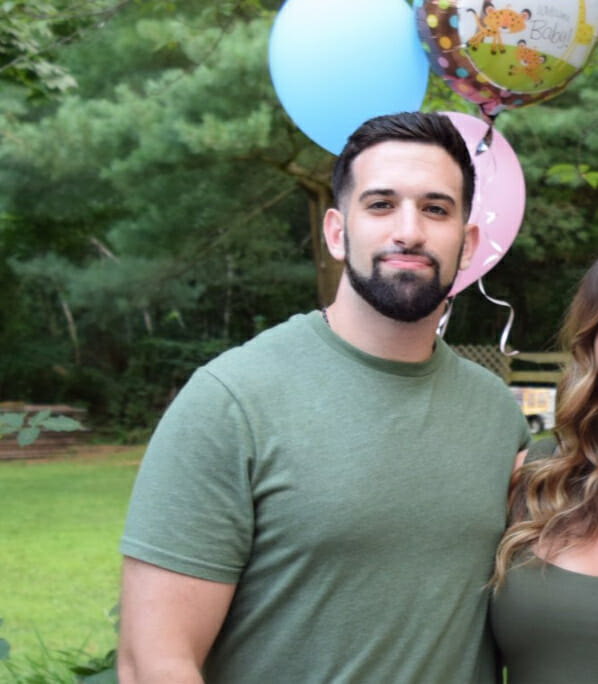
Hi there! I'm Adam, author and founder of TGL. Since 2016, I've produced and sold non-toxic kitchenware throughout the US. Today, I'm using my passion and experience in sustainable product manufacturing to help families avoid unsafe reusable foodware. When I'm not writing, you'll find me hiking or camping throughout Appalachia!
Enjoyed this post? Share it with your friends!
Related Posts
FREE Guide
Non-Toxic Kitchenware Checklist
Get a step-by-step product guide with insider tips & tricks for the safest kitchen possible!


